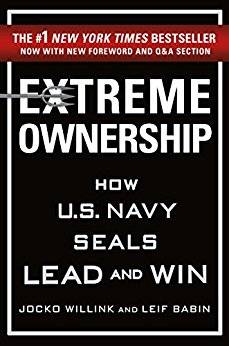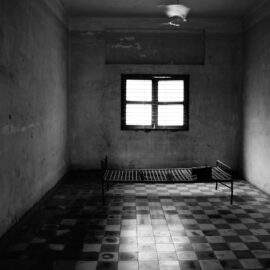
This article is an excerpt from the Shortform summary of "Extreme Ownership" by Jocko Willink and Leif Babin. Shortform has the world's best summaries of books you should be reading.
Like this article? Sign up for a free trial here .
Leif Babin is a former U.S. Navy SEAL officer who served in one of the most dangerous areas of Iraq during Operation Iraqi Freedom.
With Jocko Willink, he honed the principles of Extreme Ownership on the battlefield, then applied the same tenets to the corporate world as business consultants. Willink and Babin illustrate how effective leaders exercise Extreme Ownership — by admitting failures, believing in their missions, checking their egos, delegating, and being accountable — through compelling war stories and useful business anecdotes.
Learn how Leif Babin conducted himself in battle and how this led to his leadership ideas in Extreme Ownership.
Leif Babin Battle Story: Stay Calm, Execute, and Carry On
The SEALs are on a nighttime mission in a small village near Ramadi, where intelligence reports claim a terrorist leader (and possibly his armored group of fighters) are staying. After three months spent trying to capture the terrorist, a leader for al Qaeda in Iraq, the SEALs are determined tonight to find and kill him so that he can’t orchestrate any more attacks on U.S. and friendly forces or innocent civilians.
As troops enter the house they are targeting, a SEAL spots a squirter — someone escaping from the targeted building. The SEAL and Leif Babin, the ground force commander and leader for this operation, chase the unidentified man, unsure whether he’s the terrorist leader himself or has information about the leader’s whereabouts. They chase the man around the corner and finally catch him, but Babin realizes that not only are they now separated from their team and surrounded by buildings that haven’t been cleared for safety, but the other SEALs don’t even know where they are. Worse, a group of men are now approaching with AK-47s and other heavy weapons.
Babin’s mind is spinning with the four tasks that all need immediate action:
- Search the captive for weapons or a suicide belt
- Escape from the group of approaching enemies
- Link back up with the rest of the troops on the mission
- Resume his role as leader of the operation to ensure the mission’s success
Leif Babin remembers the words of his boss, Lieutenant Commander Willink: “Relax. Look around. Make a call.” He implements one of the Laws of Combat, Prioritize and Execute.
Babin’s first priority is to handle the group of enemy fighters. If he doesn’t address this first, he will likely be killed, and the enemies could move on to attack the rest of the nearby SEAL forces. He shoots at the group of men, killing and wounding some and dispersing the rest.
His second priority is to get himself and his fellow SEAL back to the rest of their force, in case the enemies who managed to escape regroup and come back with more fighters. To get back to their team, the two implement another Law of Combat, Cover and Move; on or off the battlefield, this strategy is all about teamwork. Leif Babin provides cover while the other SEAL moves forward, then the SEAL provides cover as Babin moves ahead. Using this method, they essentially leapfrog back to the team, bringing their prisoner along with them.
Babin’s third priority is to check the captive for explosives. Now that he and his teammate are with the rest of their force, they can hand off the captive to the SEAL team responsible for dealing with prisoners.
The final priority is for Leif Babin to resume his role as leader of the mission. He can safely turn his attention back to the operation now that the three more pressing and dangerous matters have been addressed.
By strategically prioritizing, Babin actually accomplishes everything more efficiently, as handing off the prisoner to his teammates saves him the time and trouble of checking the captive himself, while also putting the task in the hands of the experts.
The mission is not entirely successful because the SEALs don’t ultimately find or capture the terrorist leader; however, they make their presence felt and, presumably, temporarily distract the terrorist from orchestrating another attack while he finds a new place to hide.
Leif Babin Battle Story: Always Consider How Different Teams Can Help Each Other
In their efforts to take control of Ramadi from the Ira qi insurgents, the U.S. forces are using an aggressive strategy called Seize, Clear, Hold, Build. This entails forcing their way into the most strongly enemy-held neighborhoods, fighting back enemy fighters to clear the area, and then creating permanent U.S. combat outposts there.
One step in this strategy involves cordoning off a neighborhood, and then systematically searching and clearing each building in the neighborhood to ensure the area is safe. While necessary, this process is very dangerous for the U.S. troops, who risk coming face to face with enemy fighters. While U.S. forces move through the buildings, snipers are stationed strategically on a nearby rooftop to provide cover.
During one mission, the troops target a building for their sniper overwatch, but it turns out that the only clear view from the building is on a balcony where they would be exposed and visible to enemy fighters. They size up another nearby building, but find that it doesn’t offer a clear view either.
Time is running low to decide; the other teams will begin their search efforts soon and the snipers need to be in place for their safety. Babin, who is leading the team, decides the lesser of the two evils is to do the best they can from the first building.
The snipers get into position and the mission goes off successfully, with no U.S. injuries or deaths. The rest of the troops retreat back to base, while SOP calls for the sniper teams to wait until nightfall to return to camp. Although this policy is meant for the snipers’ safety — to avoid the danger of becoming walking targets as they move through the streets in broad daylight — it creates a risk in this case because they’re on a relatively exposed balcony; the building and position they’re in is not as secure as it should (and normally would) be. Hours of gunfire have already given the insurgents a decent idea of the snipers’ location, and following SOP would give them another eight to 10 hours to figure out where the snipers are and attack them.
Babin must again determine the lesser of two evils…

———End of Preview———
Like what you just read? Read the rest of the world's best summary of "Extreme Ownership" at Shortform . Learn the book's critical concepts in 20 minutes or less .
Here's what you'll find in our full Extreme Ownership summary :
- What Extreme Ownership means, and why every responsible leader needs to get it
- How to get your team working smoothly together
- How leadership principles from Navy SEAL teams work in everyday business and life






